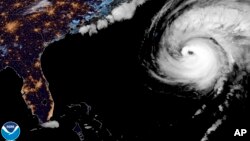The U.S. National Hurricane Center (NHC) said Friday powerful Hurricane Fiona is moving away from Bermuda to the northwest where it is expected to hit Canada later in the day as one of the strongest storms the nation has ever recorded.
In its latest advisory, the NHC reports Fiona was 200 kilometers north of Bermuda
about 1,175 km south of Halifax, Nova Scotia, on Canada’s northeast coast. Its
maximum sustained winds were reported to make it a Category 3 storm.
The forecasters say Fiona’s current path Fiona's center will then approach Nova Scotia later today, move across Nova Scotia and into the Gulf of St. Lawrence on Saturday, and then across Labrador and over the Labrador Sea on Sunday.
They say some weakening is possible, but it is expected to be “a large and powerful post-tropical cyclone with hurricane-force winds when it approaches and moves over Nova Scotia” late Friday and Saturday.
From its official Twitter account, the Canadian Hurricane Center said Fiona has the potential to be a “landmark event.” Portions of Nova Scotia, Prince Edward Island, Iles-de-la-Madeleine and Newfoundland are under hurricane warnings.
Meanwhile, far to the south, the NHC has raised concern over a tropical storm system that has not yet been named but could threaten the southern and southwestern coast of the United States.
The latest NHC advisory early Friday shows Tropical Depression Nine to be well east to southeast of Cuba. But forecasters say by early next week, there is a 90% chance the system will move into the southern Gulf of Mexico and strengthen into Tropical Storm Hermine.
The forecasters say while the ultimate path and development remains somewhat uncertain, its forecast track would have it pass over western Cuba by Monday and just off the western coast of the southeastern U.S. state of Florida.
Some information for this report came from The Associated Press and Reuters.






